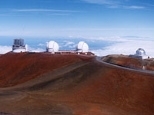BIRMINGHAM, Ala. — Pluto is undergoing global warming, as evidenced by a three-fold increase in the planet's atmospheric pressure during the past 14 years, a team of astronomers from Massachusetts Institute of Technology (MIT), Williams College, the University of Hawaii, Lowell Observatory and Cornell University announced in a press conference today at the annual meeting of the American Astronomical Society's (AAS) Division for Planetary Sciences in Birmingham, AL.
The team, led by James Elliot, professor of planetary astronomy at MIT and director of MIT's Wallace Observatory, made this finding by watching the dimming of a star when Pluto passed in front of it Aug. 20. The team carried out observations using eight telescopes at Mauna Kea Observatory, Haleakala, Lick Observatory, Lowell Observatory and Palomar Observatory. Data were successfully recorded at all sites.
An earlier attempt to observe an occultation of Pluto on July 19 in Chile was not highly successful. Observations were made from only two sites with small telescopes because the giant telescopes and other small telescopes involved lost out to bad weather or from being in the wrong location that day. These two occultations were the first to be successfully observed for Pluto since 1988.
Elliot said the new results have surprised the observers, who as recently as July thought that Pluto's atmosphere may be cooling. "From the July data, we knew that Pluto's atmosphere had changed since 1988, but the August data allowed us to probe much more deeply into Pluto's atmosphere and have given us a more accurate picture of the changes that have occurred," he said.
Jay Pasachoff, an astronomy professor at Williams College, said that Pluto's global warming was "likely not connected with that of the Earth. The major way they could be connected is if the warming was caused by a large increase in sunlight. But the solar constant--the amount of sunlight received each second--is carefully monitored by spacecraft, and we know the sun's output is much too steady to be changing the temperature of Pluto."
Pluto's orbit is much more elliptical than that of the other planets, and its rotational axis is tipped by a large angle relative to its orbit. Both factors could contribute to drastic seasonal changes.
Since 1989, for example, the sun's position in Pluto's sky has changed by more than the corresponding change on the Earth that causes the difference between winter and spring. Pluto's atmospheric temperature varies between around minus 235 and minus 170 degrees Celsius, depending on the altitude above the surface. The main gas in Pluto's atmosphere is nitrogen, and Pluto has nitrogen ice on its surface that can evaporate into the atmosphere when it gets warmer, causing an increase in surface pressure. If the observed increase in the atmosphere also applies to the surface pressure--which is likely the case--this means that the average surface temperature of the nitrogen ice on Pluto has increased slightly less than 2 degrees Celsius over the past 14 years.
Marc Buie, an astronomer at Lowell Observatory, has been measuring the amount of sunlight reflected by Pluto. "The pressure increase can be explained if the average amount of sunlight reflected by the surface has decreased, which means that more heat is absorbed from the sun," he said. "This could be the reason that the pressure has been pumped up."
David Tholen, an astronomer at the University of Hawaii who measured the size of Pluto in the late 1980s using a series of occultations and eclipses involving Pluto's satellite, noted that even though Pluto was closest to the sun in 1989, a warming trend 13 years later shouldn't be unexpected. "It takes time for materials to warm up and cool off, which is why the hottest part of the day on Earth is usually around 2 or 3 p.m. rather than local noon, when sunlight is the most intense," Tholen said. Because Pluto's year is equal to about 250 Earth years, 13 years after Pluto's closest approach to the Sun is like 1:15 p.m. on Earth. "This warming trend on Pluto could easily last for another 13 years," Tholen estimated.
Pluto and Neptune's largest moon, Triton, are presently about the same distance from the sun, and each has a predominantly nitrogen atmosphere (with a surface pressure 100,000 times less than that on Earth), so one might expect similar processes to be occurring on these two bodies.
A 1997 occultation of a star by Triton revealed that its surface had warmed since the Voyager spacecraft first explored it in 1989. On Triton, "Voyager saw dark material rising up as much as 12 km above the surface, indicating some kind of eruptive activity," Elliot said. "There could be more massive activity on Pluto, since the changes observed in Pluto's atmosphere are much more severe. The change observed on Triton was subtle. Pluto's changes are not subtle."
Researchers study faraway objects through occultations--eclipse-like events in which a body (Pluto in this case) passes in front of a star, blocking the star's light from view. By recording the dimming of the starlight over time, astronomers can calculate the density, pressure and temperature of Pluto's atmosphere. Observing two or more occultations at different times provides researchers with information about changes in the planet's atmosphere. The structure and temperature of Pluto's atmosphere was first determined during an occultation in 1988. Pluto's brief pass in front of a different star on July 19 led researchers to believe that a drastic atmospheric change was under way, but it was unclear whether the atmosphere was warming up or cooling down.
The data resulting from this occultation, when Pluto passed in front of a star known as P131.1, led to the current results. "This is the first time that an occultation has allowed us to probe so deeply into Pluto's atmosphere with a large telescope, which gives a high spatial resolution of a few kilometers," Elliot said.
From MIT, in addition to Elliot, researchers involved were physics seniors Katie Carbonari, Erica McEvoy and Alison Klesman; Kelly Clancy, technical assistant in earth, atmospheric and planetary sciences (EAPS); EAPS graduate student Susan Kern, MIT graduate Joyance Meechai (S.B. 2000); David Osip, EAPS research scientist; Michael Person, EAPS graduate student; and aeronautics and astronautics junior Shen Qu.
NASA is still deciding whether to send a spacecraft to Pluto, the only planet not yet observed at close range. The Pluto-Kuiper Belt mission in the New Horizons Program, if approved, would be launched in 2006 and would reach Pluto 10 years later. This mission will seek to answer questions about the surfaces, atmospheres, interiors and space environments of the solar system's outermost objects, including Pluto and its moon, Charon.
Researchers are looking forward to observing additional Pluto occultations in the years before the Pluto-Kuiper mission flies by Pluto. Of particular interest is the prospect of using SOFIA, a 2.5-meter airborne telescope being built by NASA in collaboration with the German space agency, for Pluto-occultation events when it begins operating in 2004. Edward Dunham, who leads the occultation effort at Lowell Observatory, also is leading a team that is building HIPO, a SOFIA instrument designed specifically to observe occultations. The combination of HIPO and SOFIA will provide very high-quality data on a much more frequent basis than is possible using ground-based telescopes alone.
"This is a very complex process, and we just don't know what is causing these effects" on Pluto's surface, Elliot said. "That's why you need to send a mission."
This work is funded by Research Corporation, the National Science Foundation, and NASA's Planetary Astronomy Program.
The team, led by James Elliot, professor of planetary astronomy at MIT and director of MIT's Wallace Observatory, made this finding by watching the dimming of a star when Pluto passed in front of it Aug. 20. The team carried out observations using eight telescopes at Mauna Kea Observatory, Haleakala, Lick Observatory, Lowell Observatory and Palomar Observatory. Data were successfully recorded at all sites.
An earlier attempt to observe an occultation of Pluto on July 19 in Chile was not highly successful. Observations were made from only two sites with small telescopes because the giant telescopes and other small telescopes involved lost out to bad weather or from being in the wrong location that day. These two occultations were the first to be successfully observed for Pluto since 1988.
Elliot said the new results have surprised the observers, who as recently as July thought that Pluto's atmosphere may be cooling. "From the July data, we knew that Pluto's atmosphere had changed since 1988, but the August data allowed us to probe much more deeply into Pluto's atmosphere and have given us a more accurate picture of the changes that have occurred," he said.
Jay Pasachoff, an astronomy professor at Williams College, said that Pluto's global warming was "likely not connected with that of the Earth. The major way they could be connected is if the warming was caused by a large increase in sunlight. But the solar constant--the amount of sunlight received each second--is carefully monitored by spacecraft, and we know the sun's output is much too steady to be changing the temperature of Pluto."
Pluto's orbit is much more elliptical than that of the other planets, and its rotational axis is tipped by a large angle relative to its orbit. Both factors could contribute to drastic seasonal changes.
Since 1989, for example, the sun's position in Pluto's sky has changed by more than the corresponding change on the Earth that causes the difference between winter and spring. Pluto's atmospheric temperature varies between around minus 235 and minus 170 degrees Celsius, depending on the altitude above the surface. The main gas in Pluto's atmosphere is nitrogen, and Pluto has nitrogen ice on its surface that can evaporate into the atmosphere when it gets warmer, causing an increase in surface pressure. If the observed increase in the atmosphere also applies to the surface pressure--which is likely the case--this means that the average surface temperature of the nitrogen ice on Pluto has increased slightly less than 2 degrees Celsius over the past 14 years.
Marc Buie, an astronomer at Lowell Observatory, has been measuring the amount of sunlight reflected by Pluto. "The pressure increase can be explained if the average amount of sunlight reflected by the surface has decreased, which means that more heat is absorbed from the sun," he said. "This could be the reason that the pressure has been pumped up."
David Tholen, an astronomer at the University of Hawaii who measured the size of Pluto in the late 1980s using a series of occultations and eclipses involving Pluto's satellite, noted that even though Pluto was closest to the sun in 1989, a warming trend 13 years later shouldn't be unexpected. "It takes time for materials to warm up and cool off, which is why the hottest part of the day on Earth is usually around 2 or 3 p.m. rather than local noon, when sunlight is the most intense," Tholen said. Because Pluto's year is equal to about 250 Earth years, 13 years after Pluto's closest approach to the Sun is like 1:15 p.m. on Earth. "This warming trend on Pluto could easily last for another 13 years," Tholen estimated.
Pluto and Neptune's largest moon, Triton, are presently about the same distance from the sun, and each has a predominantly nitrogen atmosphere (with a surface pressure 100,000 times less than that on Earth), so one might expect similar processes to be occurring on these two bodies.
A 1997 occultation of a star by Triton revealed that its surface had warmed since the Voyager spacecraft first explored it in 1989. On Triton, "Voyager saw dark material rising up as much as 12 km above the surface, indicating some kind of eruptive activity," Elliot said. "There could be more massive activity on Pluto, since the changes observed in Pluto's atmosphere are much more severe. The change observed on Triton was subtle. Pluto's changes are not subtle."
Researchers study faraway objects through occultations--eclipse-like events in which a body (Pluto in this case) passes in front of a star, blocking the star's light from view. By recording the dimming of the starlight over time, astronomers can calculate the density, pressure and temperature of Pluto's atmosphere. Observing two or more occultations at different times provides researchers with information about changes in the planet's atmosphere. The structure and temperature of Pluto's atmosphere was first determined during an occultation in 1988. Pluto's brief pass in front of a different star on July 19 led researchers to believe that a drastic atmospheric change was under way, but it was unclear whether the atmosphere was warming up or cooling down.
The data resulting from this occultation, when Pluto passed in front of a star known as P131.1, led to the current results. "This is the first time that an occultation has allowed us to probe so deeply into Pluto's atmosphere with a large telescope, which gives a high spatial resolution of a few kilometers," Elliot said.
From MIT, in addition to Elliot, researchers involved were physics seniors Katie Carbonari, Erica McEvoy and Alison Klesman; Kelly Clancy, technical assistant in earth, atmospheric and planetary sciences (EAPS); EAPS graduate student Susan Kern, MIT graduate Joyance Meechai (S.B. 2000); David Osip, EAPS research scientist; Michael Person, EAPS graduate student; and aeronautics and astronautics junior Shen Qu.
NASA is still deciding whether to send a spacecraft to Pluto, the only planet not yet observed at close range. The Pluto-Kuiper Belt mission in the New Horizons Program, if approved, would be launched in 2006 and would reach Pluto 10 years later. This mission will seek to answer questions about the surfaces, atmospheres, interiors and space environments of the solar system's outermost objects, including Pluto and its moon, Charon.
Researchers are looking forward to observing additional Pluto occultations in the years before the Pluto-Kuiper mission flies by Pluto. Of particular interest is the prospect of using SOFIA, a 2.5-meter airborne telescope being built by NASA in collaboration with the German space agency, for Pluto-occultation events when it begins operating in 2004. Edward Dunham, who leads the occultation effort at Lowell Observatory, also is leading a team that is building HIPO, a SOFIA instrument designed specifically to observe occultations. The combination of HIPO and SOFIA will provide very high-quality data on a much more frequent basis than is possible using ground-based telescopes alone.
"This is a very complex process, and we just don't know what is causing these effects" on Pluto's surface, Elliot said. "That's why you need to send a mission."
This work is funded by Research Corporation, the National Science Foundation, and NASA's Planetary Astronomy Program.








